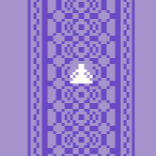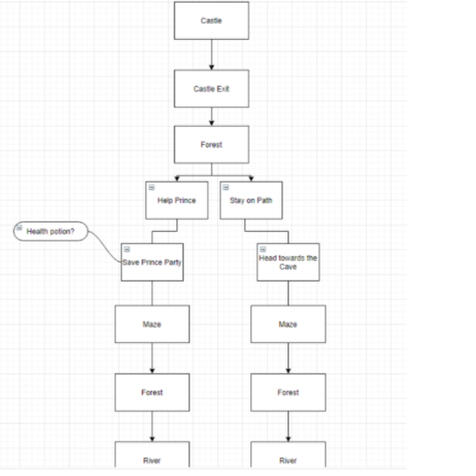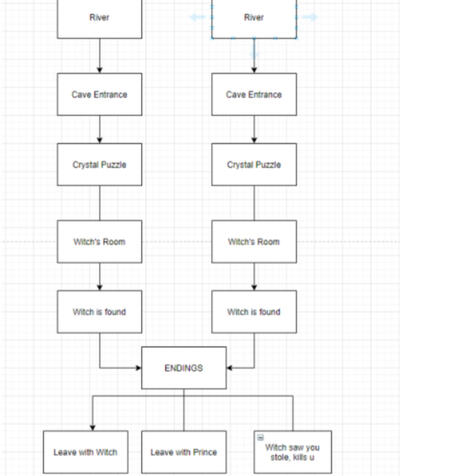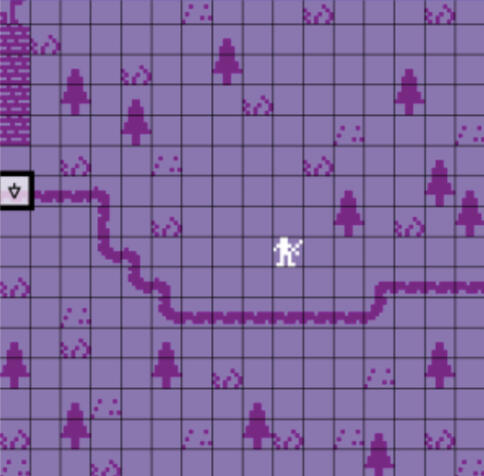
On the Fence
GAM 224 Post Mortems
Kingsley's Post Mortem
To begin with our game On the Fence, our team was initially torn on whether we should prioritize mechanics or story. We knew that many groups would be using Twine but through a friend, I was loosely familiar with Bitsy and recommended it to the group. The group members seemed excited at the opportunities Bitsy had to offer - namely, the ability to easily create visual effects to go with our story. I let them know we would be limited mechanically because Bitsy is a very simple game engine, but we went ahead because we fell in love with the engine.
We then divided up the roles. Alyssa would be our main game engine coder, dealing with anything code-heavy or complex within Bitsy, such as the teleports and player inventory. Muzzy would focus primarily on the art of the game, establishing the map and the style. Tory and I would work to complete the dialogue and I would also serve as the leader during meetings and I would keep us on track between meetings. There was discussion of Tory and I choosing music for the game as well, but because this was not in the base Bitsy game engine, we opted to not stretch ourselves thin and try to handle a Bitsy “hack” or mod which would allow music.
While spit-balling and introducing ourselves, Muzzy let us know that they have an abundant collection of crystals that they collect. We discussed how beautiful crystals are and how it would be neat to feature crystals in the game, perhaps in a cave full of glittering crystals. That was the first seed of the story in our mind. We then build the world around that cave, establishing a medieval setting and a witch that was hidden away in the cave. We talked about the tropes of medieval settings and how we wanted to flip them -- we didn’t want the Prince to be a savior, we wanted him to be saved.
But this was only our first meeting as a group and there was still a lot to be decided. We had no motivation for why the witch would be seen as evil, we did not know why the Prince had to be saved, and we had not yet decided who the witch was. Despite this, we wanted to get the ball rolling to ensure we wouldn’t be overwhelmed with work at the end of the quarter. So Muzzy built the map of the world with Alyssa’s help with the coding. She did a significant portion of the graphics upfront and I was happy to finish up what was remaining. During our next meeting, we would finish establishing the story.
We decided that we wanted the witch to be a sympathetic “villain.” And we realized in turning the trope of the Knight in Shining Armor on its head, we had inadvertently created an internal bias against the Prince. I challenged the team to keep the trope flipped but to make the Prince sympathetic as well, even though the instincts of some team members was to write him as a bad person. We decided that we would split up the characterization of the characters between the team. I took on the Princess, Muzzy developed the Prince, and Tory wrote the witch. I then created an Excel sheet to organize the dialogue necessary for these characters. We were originally working on a lengthy Google document but this was quickly inadequate for the purposes of organization.
I struggle to describe the different “iterations” of the game because while there were certainly different stages of the game’s development, we did not experiment with different styles of gameplay or setting. The “iterations” were just incomplete versions of the game. That said, it was still necessary to test these iterations and make sure that they were developing as they should. The first iteration of the game was essentially an empty map with some graphics laid in by Muzzy. I took this and added some more graphics to finish filling it all out, but when we playtested this, we realized that one of the locked exits would not unlock when the player had an item in their inventory - it wasn’t working the way it was intended. So when we playtested, we had to ask them for feedback more about the environment and tell them about the story of the game so there was something for them to work with.
The next iteration of the game had dialogue in it, along with the crystal puzzle, although we found in playtesting that the puzzle wasn’t working as intended. Players would pick up the crystals without knowing what they were for and then approach the locked door and not understand there was a riddle to be solved. However, since they had already picked up the crystals, the door would unlock. So we received feedback about that from our playtesters but overall, it seemed the dialogue (the major change from the last iteration) made the story clear enough. The players were excited to talk about whether they chose the witch or the prince and that was exciting for us.
In the final iteration, I changed the crystal puzzle to try to make it more intuitive, but failed to fix some of the surrounding dialogue. The prince still referred to crystals before the player had even seen crystals and the riddle repeats when you interact with the door after having a crystal in your inventory. Overall, it’s sort of a clumsy fix for the issue, but it seemed to work as intended - the players interacted with the locked door before exploring the crystal room. So in the final file version which was uploaded to D2L, the surrounding dialogue was fixed and we adopted the new crystal puzzle. It probably would have been more effective to thoroughly change the game, including the dialogue, when we playtested the new crystal puzzle but that is something for us to learn for future projects: be thorough! That said, it's certainly difficult to find the balance between being done with something and still polishing it. I keep finding more things to perfect about the game.
Muzzy's Post Mortem
The game ‘On the Fence’ started after our team had discussed what platform we’d be using for our project. The choices stood between Twine, Castle or Bitsy. We figured the best approach would be to run a quick test of each platform and build a story based around what platform we liked best. As we had prior brainstorming that determined we wanted a visual, story-based game we had decided that Bitsy would be the best option. Our biggest issue would be making cooperative work as Bitsy doesn’t have an account or team-work option. We had determined we would upload the game data of each version of the game in number order to our shared Google Drive Folder. This way we would paste the newest game data into Bitsy which will give us access to the map, sprites, text and exits made by the person who edited the game last.
Our game mechanics stemmed from our first few days tinkering with the Bitsy platform in order to determine what we could and could not do with our game. After playing some other games made by people we know, we were able to connect the ‘play’ aspect for the platform and the ‘creation’ aspects. By looking through Bitsy we found that we could only move our avatar, as other NPS wouldn't be able to move across the map. We had creative freedom with the map as long as it fell under the pixel size and limited color palette. Our final stance on the game mechanics came too, “On the Fence is a 8-bit single-player story game with a whimsical theme and strategic puzzles. This choose your own adventure style game sets you in the feet of a Princess who is setting out to confront a threat to her Kingdom. The role-playing and experience based play allows players to be thrown into the game, travel through the land, and determine their own fate.
Play begins with the Princess speaking to her advisors, after which she starts off on her journey to help the Kingdom. By controlling the single avatar up, down, left or right, the player moves across the different scenes and interacts with sprites and items. Some of these sprites and items are there for story, while others will impact the game’s ending. After completing a set of puzzles and obtaining information from sprites, the player will be given one last decision that will impact the final ending of the game. Those endings include two endings, both of which are “good,” but are dependent on the player’s choices. There are little to no ways to play the game outside of intended gameplay, as players are limited to pre-designed endings, choices, and map locations.”
After looking through the platform we began expanding on our story. Determining who the ‘hero’ of the story would be, in our case the Princess, and the villain being an evil witch kidnapping the kingdom’s citizens. From there we worked with other characters, such as a Prince who had gone to fight the Witch and advisors you meet at the beginning of the game that set the story.
The original creation plan was simple. First the map was built based on a flowchart created to track parts of the game. Next, we would add the avatar, sprites and items in their designated spots. Then, dialogue would be added to the game. Lastly, exits and endings which would complete everything we needed. In reality, it wasn’t this easy as we had many bumps in the road. Sometimes working with Bitsy itself as aspects of its ‘locked exit’ system or branching dialogue would get confusing. Other issues included determining how we would get players to move freely yet still follow an intended path and figuring out how to provide players with information about the story in a natural way.
After our first playtest in class we found what aspects of the game would be confusing to the players. We discovered we should rethink the placement of the ‘crystal puzzle’ and also make some dialogue clearer. There were positive feedbacks to the map and the story overall!
Our different iterations of the game are pieces with specific chunks of the game missing. As the 2nd iteration is just map work and sprites, the 4th is map, sprites, dialogue but still had issues with endings and the puzzle. The final iteration, 7, is complete with every aspect of the game but had a few bumps in the ‘puzzle’ scene. As our first playtest didn’t have any text we were unable to work out our “Bear Scene” which in the later playtestings shown to have an issue with dialogue and the order of which players interacted with the Prince and the items.
The earlier versions of the game that only consisted of the map were able to give us feedback on how the players move around the space, interact with sprites and items. We found we had to move the crystal pedestals lower in the scene as it would disrupt the player’s path towards the locked door on the other end of the scene. Player’s were also unable to get past said door so we had to look into working out the game’s lock system.
In the later, but not complete versions we were able to get breakdowns of feedback on overarching topics, such as: are you able to follow the story?
While watching playtesters work through current dialogue we got further answers to how we should present players with information and what points we should specify in the story.
We found the most complicated detail was to be able to provide the player freedom in playing but also follow a predetermined path. For example, we expected players to interact with the fallen Prince before reaching for the sword or potion. The players who collected the sword first ended up missing a chunk of the story detail as the branching text system concluded that the player had the sword so it would play the later dialogue.
Overall, I feel as though we were able to bring a majority of our story to life through this game. Although we still have a few bumps in the road, we can use the play tests of the final version to further edit the game. It goes to show that you can never really stop testing the game as there’s always something new to fix.
Tory's Post Mortem
The game On The Fence started off as several thoughts and ideas that became meshed into one. My group knew from the very beginning that we wanted to create a game that was not only story based, but a game that highlights adventure, and gives the player the ability to choose their own path. We battled with lots of constraints such as this being a single player game. Also, we were very concerned about the platform (Bitsy) that we choose considering that it was available on desktop through any browser, but barely functional on mobile or tablet devices. This was a very big issue in the beginning considering that the only device I owned was a iPad and/or tablet device. At this point we knew that splitting up the work was going to be a bit more tricky and complex. Some other constraints in the beginning were the mechanics and the imperfect information spaces. We were concerned that players wouldn’t know how items/characters would react when they interacted with them, and how they wouldn’t know that their choices throughout the game would impact the ending of the game. We did our research and figured out that Bitsy was the best option/platform to make our ideas come to life. We did battle with other names for our game for some time. One of my favorite titles for the game that didn’t see the daylight is called Bit by Bit. Although this name was catchy, we all agreed that it just wasn’t what we were looking for.
In the beginning, there were two original characters that we knew had to be apart of the game—the princess and the prince. These two characters paved a pathway of ideas and allowed us to be creative with other aspects of the game. There are thousands of games in the world that involve a princess and a prince so we thought to ourselves, how can this game be different and unique? The main goal of the game is that the players are trying to solve the mystery of the missing citizens of the kingdom. Players must complete obstacles such as puzzles, mazes, ect., all while trying to choose what path they want to take. This is a role playing, experienced based, and player-versus-game design. Upon making the final game decision, players will have the opportunity to choose one of the two endings of the game. Before we reached these final decisions, we started with the idea of venturing through a mystical world. We originally had this idea that the prince was going to be hated and the princess was going to be viewed as the almighty, brave, and powerful women that she is. The first thing we did was discuss the story aspect of the game. We generated different charters and different settings to add to our story. Our game pitch started off with a mere story that we then developed into actual concepts and rules. Our first pitch of the game involved a small plot description involving the princess and the prince. We had not even thought about the other main character (The Witch) in the beginning.
Also, at this point we did not yet discover that we were going to add mazes, puzzles, and other aspects to keep players absorbed into the game. We started with a flowchart of ideas that developed into something much bigger. After the flowchart is when the team started to build the map and add sprites to the game.
One of the more challenging aspects of the game is the fact that we had to make sure every idea that we pitched was able to be inputed into the platform Bitsy. As said before, I only own a iPad so I could not help out with the coding and such, but from what my group members shared with me—this was a very challenging process. My journey throughout creating this game was much different from my group members. I was in charge of creating the NPC Dialogue, creating the game trailer, finding music, adding in story input/game ideas, and completing/finalizing documentation. I would say that my journey was a very fun one, however, even though I wasn’t able to create the physical game itself, my ideas still live inside this majestic in-game kingdom.
After our final play-test, we received some very insightful feedback. It was very important to take notes and ask the other members of the design team plenty of questions to ensure the success of our game moving forward. It was very important to observe what they did and didn’t like about the game, what paths were taken, and what the players interacted with throughout their gameplay. Some questions that we’re brought to light amongst our group we’re vital to the development of our game; did the players enjoy the pacing of the game, did the players feel that music and sound effects would add more to the game, and overall, how did they feel about the entirety of the game? After the play-testing, it was my job to read through the dialogue to make sure everything made sense all while making suggestions to better the game and make it more enjoyable. My contribution was a lot of me voicing my thoughts and opinions about the game—what we should and shouldn’t do. After play-testing, we noticed that the game wouldn’t allow the players to choose the path of the prince (one of the game’s endings). Of course, I had no idea how to approach or fix this issue considering that I had nothing to do with the coding aspect of the game. All I could do is encourage my group members. At times, it did break my heart because I only have a iPad and my work schedule is utterly hectic, so I couldn’t help with certain aspects of the game like fixing the prince’s ending. Other feedback was very positive after the play-test, and it made me feel very happy/excited to see that people loved our ideas. Of course there were a few small details that needed to be adjusted, but our game stood strong.
There were at least 3 distinct game iterations, and all three are supported in a separate document. There is basically three versions of our game—version 2, 4, and 7. Version 2 consisted of the map itself. This is when we all put our input in to decide the color way of the game. We all agreed that a pink or purple best suits the story line that we we’re going for. Version 2 is also the broken version of the game where you can’t get past the locked door inside the cave. At this point, I had no idea how I was going to help my team considering I knew nothing about the coding of the game. All I could do was voice other alternatives to eliminate the issue.
Version 4 is where we adding more maps, sprites, and dialogue that I helped create. Later down the road, we figured out that this version too had some issues. Players were able to pick up all of the crystals and the puzzle was not working in the way that we intended. I suggested that we leave it the way that it is because being able to interact with all of the crystals is still very beneficial to the other players. It might have been confusing, but at least they were able to see the dialogue, and interact with them.
Version 7 (the final version) is what we are the most proud of. The dialogue is a bit confusing around the crystal puzzle, because we left is alone as planned. I will never forget how difficult it is to be a game designer, and this game will live with me forever. My team all contributed in their own way, and if I had to do it all over again, I would gladly do so!






